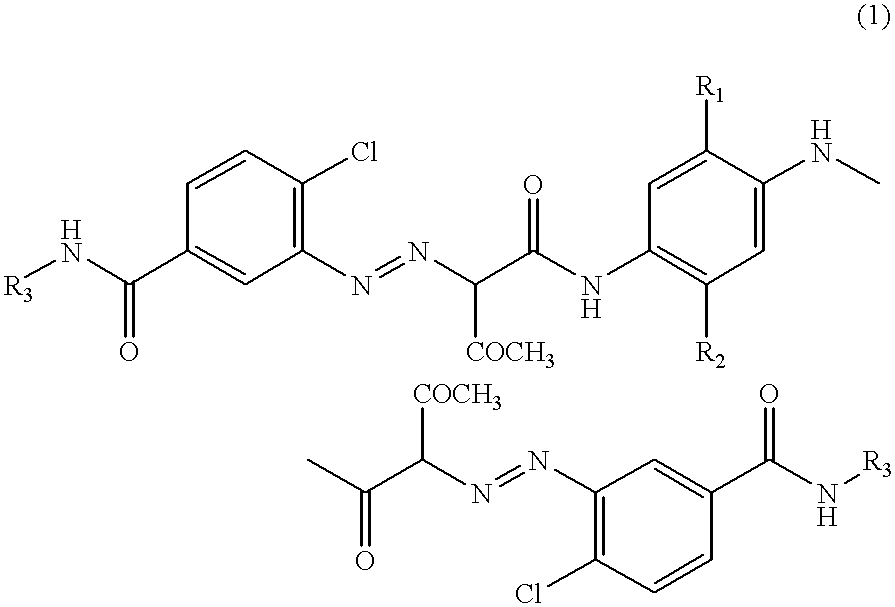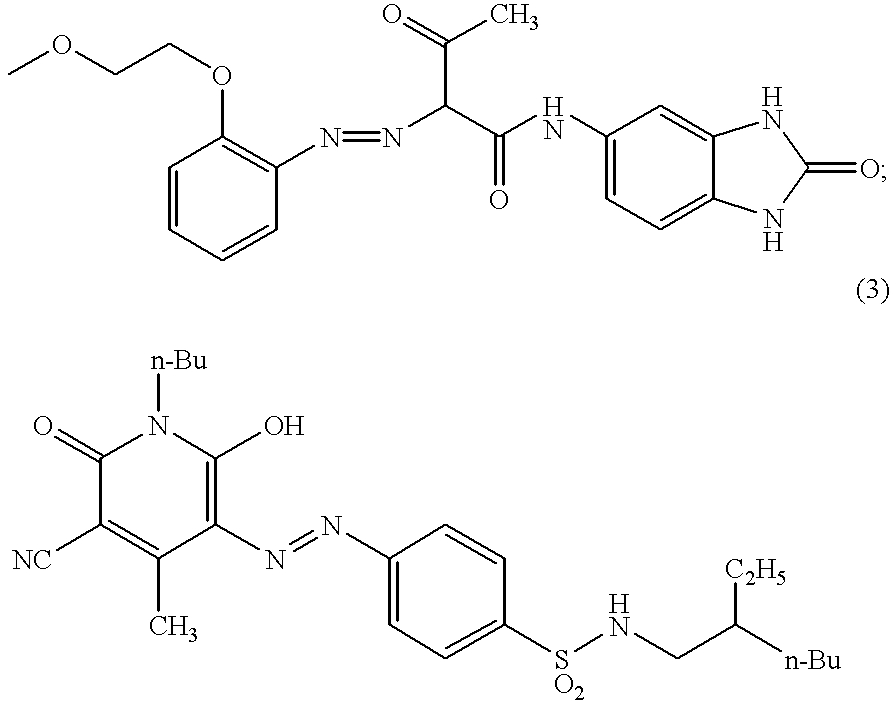These methods are both excellent methods capable of relatively stably providing good images but are accompanied with common difficulties arising from the use of a two-component developer, such as accumulation of spent toner on the carrier surface and the change in
mixing ratio between the toner and the carrier.
However, a magnetic monocomponent developer has a constraint of containing
magnetic powder therein so that it is frequently used in providing black toner but is not used for providing toners used in full-color development in many cases.
The use of a nonmagnetic monocomponent developer is accompanied with advantages, such as stabler control of developer concentration, simplification of components used in the apparatus and facilitation of accomplishing a compact apparatus body, but is liable to cause
instability in charge-imparting performance and toner scattering in the apparatus compared with a conventional two-component developer including carrier particles.
In recent years, however, not a few magnetic monocomponent developers capable of providing improved image qualities have been proposed accompanying a remarkable improvement in chargeability, whereby it is becoming possible to effect full-
color image formation by using nonmagnetic monocomponent developers, which has been considered difficult heretofore.
Further, as some portion of the toner particles is agglomerated, the uniform charging of the toner particles is liable to be difficult.
Particularly, in the case of full-
color image formation wherein monochromatic toners are used for developing and transferred plural cycles at a
latent image portion to form multi-layer toner images for providing a
full color image, the latent images are liable to lower the potential as they approach the surfacemost images, so that the toner developing performance is liable to change between toners for the uppermost layer and the lowermost layer.
Further, in the full-
color image formation, a color mizability under heat-melting is also an important factor, and when a developer having poor color mixability is used, not only it becomes impossible to attain faithful
color reproduction but also difficulties such as a lowering in transferability and toner scattering onto non-image potential parts can be caused.
Corresponding thereto, the charge of a developer on the developer-carrying member is liable to be excessively large in a low temperature / low
humidity environment, thus being liable to cause so-called "charge-up".
Such an excessively charged developer is liable to cause melt-sticking onto the electrostatic image-bearing member when it is disposed on the electrostatic image-bearing member and receives some force from a member abutting thereto.
However, there have been found some insufficiencies in such processes in order to comply with further demands on the market.
However, such processes are yet insufficient in providing toner particles of a minute particle size in an
aqueous medium.
For example, the process of using a graft-treated colorant (disclosed in JP-A 56-116044) causes an increased production cost, and the particle forming characteristic of the
monomer composition containing the colorant is liable to be insufficient due to the polymerizate of the
grafting monomer.
Further, a toner obtained by using a colorant treated with dispersant of a
coupling agent-type or a surfactant-type is liable to have inferior chargeability, thus being liable to cause
fog.
However, the JP reference does not disclose an example of toner containing different colorants, thus failing to disclose an effect of
combined use of different colorants.
Such dyes can be very easily dispersed in a toner, but the use thereof has been found to involve some problems.
One problem is that a dye has a markedly lower hiding
powder than a colorant, so that it is sufficient to form an image on an overhead
projector transparency sheet for providing
transmitted light image, but an image for providing a reflected light image is liable to be affected by a transfer material on which the image is formed.
More specifically, an image formed on paper as a transfer material is 1) liable to exhibit a different color
hue affected by the ground color of the paper, and 2) liable to provide a poor
halftone image with a vague boundary with the ground color because of a small toner coverage for providing the
halftone image.
These difficulties are particularly pronounced in the case of a yellow toner having a high
lightness.
As has been discussed above, a toner containing a colorant with a sufficient dispersibility and exhibiting satisfactory performances has not been obtained so far.
Particularly, a toner having a smaller particle size is more liable to be affected with respect to its chargeability due to localization of the colorant therein.
The problems with smaller particle size toners are liable to be pronounced in lower-gloss images as produced in printing with a photomechanically processed plate according to a recent users' preference.
Further, as a problem different from the dispersibility of a colorant, a toner in a fixed toner image is required to be substantially completely melted to an extent that toner particle shapes cannot be discriminated so as not to obstruct
color reproduction due to random reflection at the fixed toner image.
For this purpose, incomplete melting of toner particles becomes necessary and the
resultant images are noticeably affected by toner-
scattered light.
Accordingly, conventional combinations of color toners as proposed in the above JP references have become insufficient.
It has been also found that a toner resin designing for preventing complete melting of toner particles results in a toner image on a transparency film causing
light scattering due to incomplete melting of the toner particles, thus resulting in a narrower reproducible color region.
It has been also found that incomplete toner melting also results in a
hue angle change, thus being liable to fail in objective
color reproduction.
Further, in printer use, it is often required to output black character images in mixture with color images which are liable to have a larger toner coverage than the black images according to a
conventional technique.
It has been also found that if the toner coloring power is increased in order to compensate for an
image density lowering due to
light scattering at image surface,
fog is liable to be noticeable.
This is because a scattered toner image is supplied with a relatively larger heat quantity to exhibit a higher gloss causing an apparently higher
image density, thus resulting in noticeable
fog.
This leads to a problem of increased toner consumption for a desired
image density.
However, the particles of at most 5 .mu.m are as little as at most 15% by number, thus being liable to form images lacking
clarity.
However, toner particles of at most 5 .mu.m show a particularly strong attachment force onto the latent image-bearing member surface, thus being liable to cause a difficulty in cleaning of transfer residual toner.
If a printing operation is continued while the cleaning of transfer residual toner is insufficient, the sticking of low-resistivity substances, such as
paper dust and
ozone adduct, and the toner onto the photosensitive member, is liable to occur.
This is effective for alleviating the toner sticking, but the desired
abrasive effect cannot be readily attained unless the charging stability of the developer is not improved, so that a sufficient stabilization of cleaning performance has not been accomplished.
Further, as a result of the inclusion of identical
chemical species of inorganic fine particles (e.g., silica), in addition to the flowability improvement, the toner chargeability is liable to be unstable, thus being liable to cause toner scattering and fog.
However, as the silica particles have a large BET specific surface area, it is difficult to attain a remarkable spacer effect among toner particles.
However, these yellow pigments cannot yet be said to be satisfactory pigments for providing yellow toners exhibiting further improved image forming performance and chargeability.
 Login to View More
Login to View More  Login to View More
Login to View More 


